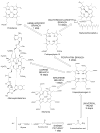The tetrapyrrole biosynthetic pathway and its regulation in Rhodobacter capsulatus
- PMID: 20532744
- PMCID: PMC2883787
- DOI: 10.1007/978-1-4419-1528-3_13
The tetrapyrrole biosynthetic pathway and its regulation in Rhodobacter capsulatus
Abstract
The purple anoxygenic photosynthetic bacterium Rhodobacter capsulatus is capable of growing in aerobic or anaerobic conditions, in the dark or using light, etc. Achieving versatile metabolic adaptations from respiration to photosynthesis requires the use of tetrapyrroles such as heme and bacteriochlorophyll, in order to carry oxygen, to transfer electrons, and to harvest light energy. A third tetrapyrrole, cobalamin (vitamin B(12)), is synthesized and used as a cofactor for many enzymes. Heme, bacteriochlorophyll, and vitamin B(12) constitute three major end products of the tetrapyrrole biosynthetic pathway in purple bacteria. Their respective synthesis involves a plethora of enzymes, several that have been characterized and several that are uncharacterized, as described in this review. To respond to changes in metabolic requirements, the pathway undergoes complex regulation to direct the flow of tetrapyrrole intermediates into a specific branch(s) at the expense of other branches of the pathway. Transcriptional regulation of the tetrapyrrole synthesizing enzymes by redox conditions and pathway intermediates is reviewed. In addition, we discuss the involvement of several transcription factors (RegA, CrtJ, FnrL, AerR, HbrL, Irr) as well as the role of riboswitches. Finally, the interdependence of the tetrapyrrole branches on each other synthesis is discussed.
Figures


 ⌷ based on both gene expression and DNA binding studies), FnrL (◊, repressor; ◈, activator), AerR (⊗), CrtJ (★), HbrL (⊥). Arrows indicate a feedback control by heme operated through CrtJ or HbrL. Genes identified from bioinformatics analysis only, with no experimental studies, are specified with a question mark.
⌷ based on both gene expression and DNA binding studies), FnrL (◊, repressor; ◈, activator), AerR (⊗), CrtJ (★), HbrL (⊥). Arrows indicate a feedback control by heme operated through CrtJ or HbrL. Genes identified from bioinformatics analysis only, with no experimental studies, are specified with a question mark.Similar articles
-
Regulation of hem gene expression in Rhodobacter capsulatus by redox and photosystem regulators RegA, CrtJ, FnrL, and AerR.J Mol Biol. 2004 Sep 24;342(4):1171-86. doi: 10.1016/j.jmb.2004.08.007. J Mol Biol. 2004. PMID: 15351643
-
Vitamin B12 regulates photosystem gene expression via the CrtJ antirepressor AerR in Rhodobacter capsulatus.Mol Microbiol. 2014 Feb;91(4):649-64. doi: 10.1111/mmi.12491. Epub 2014 Jan 9. Mol Microbiol. 2014. PMID: 24329562 Free PMC article.
-
Tetrapyrrole biosynthesis in Rhodobacter capsulatus is transcriptionally regulated by the heme-binding regulatory protein, HbrL.J Bacteriol. 2006 Feb;188(4):1567-76. doi: 10.1128/JB.188.4.1567-1576.2006. J Bacteriol. 2006. PMID: 16452440 Free PMC article.
-
Sulfate-reducing bacteria reveal a new branch of tetrapyrrole metabolism.Adv Microb Physiol. 2012;61:267-95. doi: 10.1016/B978-0-12-394423-8.00007-X. Adv Microb Physiol. 2012. PMID: 23046956 Review.
-
Oxygen-regulated expression of genes for pigment binding proteins in Rhodobacter capsulatus.J Mol Microbiol Biotechnol. 2002 May;4(3):249-53. J Mol Microbiol Biotechnol. 2002. PMID: 11931555 Review.
Cited by
-
A comparative genomics perspective on the genetic content of the alkaliphilic haloarchaeon Natrialba magadii ATCC 43099T.BMC Genomics. 2012 May 4;13:165. doi: 10.1186/1471-2164-13-165. BMC Genomics. 2012. PMID: 22559199 Free PMC article.
-
Prokaryotic Heme Biosynthesis: Multiple Pathways to a Common Essential Product.Microbiol Mol Biol Rev. 2017 Jan 25;81(1):e00048-16. doi: 10.1128/MMBR.00048-16. Print 2017 Mar. Microbiol Mol Biol Rev. 2017. PMID: 28123057 Free PMC article. Review.
-
Chlorophyll biosynthesis gene evolution indicates photosystem gene duplication, not photosystem merger, at the origin of oxygenic photosynthesis.Genome Biol Evol. 2013;5(1):200-16. doi: 10.1093/gbe/evs127. Genome Biol Evol. 2013. PMID: 23258841 Free PMC article.
-
The chloroplast proteome: a survey from the Chlamydomonas reinhardtii perspective with a focus on distinctive features.Curr Genet. 2011 Jun;57(3):151-68. doi: 10.1007/s00294-011-0339-1. Epub 2011 Apr 30. Curr Genet. 2011. PMID: 21533645 Review.
-
Microbial production of vitamin B12: a review and future perspectives.Microb Cell Fact. 2017 Jan 30;16(1):15. doi: 10.1186/s12934-017-0631-y. Microb Cell Fact. 2017. PMID: 28137297 Free PMC article. Review.
References
-
- Alberti M, Burke DH, Hearst JE. Anoxygenic photosynthetic bacteria. Kluwer Academic Publishers; Dordrecht, The Netherlands: 1995.
-
- Armstrong GA, Schmidt A, Sandmann G, et al. Genetic and biochemical characterization of carotenoid biosynthesis mutants of Rhodobacter capsulatus. J Biol Chem. 1990;265:8329–8338. - PubMed
-
- Avissar YJ, Moberg PA. The common origins of the pigments of life early steps of chlorophyll biosynthesis. Photosynth Res. 1995;44:221–242. - PubMed
Publication types
MeSH terms
Substances
Grants and funding
LinkOut - more resources
Full Text Sources
Molecular Biology Databases

